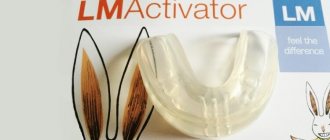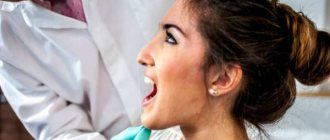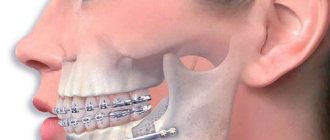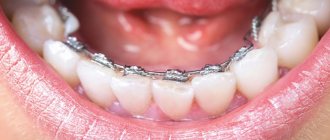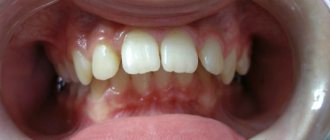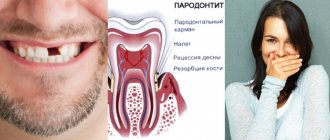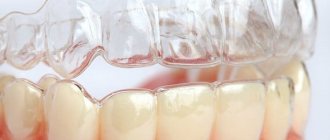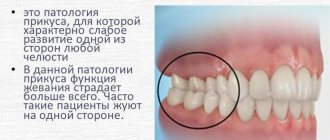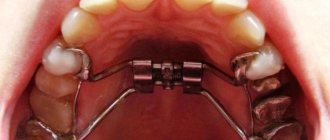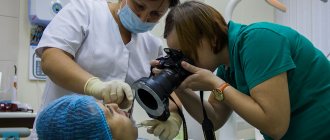593
Today, correcting the bite or aligning the position of individual elements in children of preschool or primary school age does not pose any problems.
In orthodontics, there are many methods and designs for this. The domestically produced elastopositioner “Corrector” has been in greatest demand in recent years.
Purpose and characteristics of the product
The “Corrector” device is a Russian elastopositioner. It is a set of two mouthguards produced in a factory.
The model is made of medical silicone and has 8 standard sizes. The entire course of treatment is carried out in one set without replacement.
The principle of operation of the elastopositioner “Corrector” is based on the forced installation of the jaws in the correct position relative to each other in the vertical and horizontal direction. This allows you to position the heads of the maxillary joints in a physiologically optimal position, normalize the bite, and eliminate the increased tone of the masticatory muscles.
In addition, the elastic force of the elastomer acts on abnormally located individual teeth and segments of the dentition, causing them to shift to their normal position.
The “corrector” has developed lingual and palatal edges, ensuring reliable fixation of the mouthguard in the patient’s mouth. The tongue shield prevents bad habits. Palatal and buccal pilots remove the mucous membranes of the cheeks and lips from the dentoalveolar areas, promoting the correct development of the jaws.
The mouthguards have enlarged breathing holes, making it possible to breathe through the mouth with the teeth closed. This is necessary during the period of transition from mouth breathing to nasal breathing, as well as for people with apnea syndrome (breath holding during sleep).
The elastopositioner is designed to eliminate myofunctional (muscular) disorders (chewing, breathing, speech, tongue articulation), malocclusion, and TMJ dysfunction.
It is possible to use the system as a retention device to consolidate the results of treatment with braces , as well as a means of preventing dental anomalies. Treatment with an elastopositioner relieves night snoring and apnea.
The device can be used as a pre-correction (before installing braces) and post-correction (consolidating the treatment result) device, as well as an independent (single) means of treatment.
The “corrector” allows for the manufacture and use simultaneously of additional orthodontic elements (spring, wire and elastic ligatures, hooks, stoppers).
What is the Bruxogard trainer and indications for its use.
Come here if you are interested in the features of the I3 trainer.
At this address https://www.vash-dentist.ru/ortodontiya/treyneryi/sustavnaya-shina-tmg.html instructions for using the TMJ articular splint are offered.
What is an elastopositioner
Elastopositioner 1 is an elastic myofunctional device or dental guard made of elastomer or medical silicone.
Silicone teeth corrector retains elasticity for a long time, but at the same time has increased elasticity. The material from which the elastopositioners are made is hypoallergenic, does not cause discomfort, does not injure the gums and mucous membranes, but at the same time it affects not only the dentition, but also the jaw (normalizes its growth). Elastic positioners are always removable and, which is very important, double-jawed. That is, they represent a single structure that is fixed on both jaws at once and allows you to adjust their position relative to each other. You can see what the design looks like in the photo.
Why are structures called myofunctional?
A dental corrector such as an elastopositioner not only corrects bite pathologies, but also relieves the patient of the causes that provoked its violation, that is, from bad habits that contribute to dysfunction of the maxillofacial apparatus. For example, incorrect positioning of the tongue, incomplete closure of lips and mouth breathing.
Elastic positioners help strengthen and train the orbicularis oris muscle, eliminate dysfunction of the temporomandibular joint, help get rid of snoring and apnea, normalize sleep and speech, relieve pain and hypertonicity of the masticatory muscles.
When are bite correctors prescribed?
The problem of eliminating occlusion disorders is very acute at any age. Therefore, bite correctors are universal devices that can be used from the age of three until the end of life. The design is a non-removable device that is installed inside the oral cavity. The patient is in contact with the device for a full day. This provides a quick effect despite some slight discomfort while wearing.
Bite correctors are intended as the sole treatment method, as well as in combination with other intraoral appliances. The main indications for their use can be presented as follows:
- distal bite;
- lateral displacement of dental occlusion;
- consequences of injuries and operations;
- insufficient effect from braces or removable devices (trainers);
- activation of the growth of any jaw in combination with other devices;
- anomalies in the development and formation of the dentition.
The main purpose of fixed appliances is to correct distal occlusion. For this purpose, they are prescribed, depending on the model, during the period of mixed dentition or throughout life after changes in the facial skeleton. The main mechanism of action of the devices is the load on the lower jaw in order to reduce its prognathism. The principle of operation is mechanical, carried out due to the resistance force of the rubber rods of the device.
How much to wear
For the first 2 days you need to wear it as long as possible. Therefore, immediately after removing the edgewise system, performing professional hygiene, and remineralizing therapy, this device should be ready for use. Then they switch to a 4-hour daytime + nighttime mode. How long should I wear the positioner? The effect of its use as a final means of setting teeth ends after 3 weeks. Then, if it is used, it is as a removable retainer.
Types of bite correctors and their features
There are quite a few manufacturers of bite correctors. Each of them has its own installation and application features. However, the vast majority of devices are characterized by a mechanical type of effect on bone structures, and the possibility of use is determined only by a dental specialist. The most current devices used in modern practice are discussed below.
- One of the first to appear on the Russian market. It has a rather bulky telescopic mechanism. But it is quite convenient for severe cases of distal occlusion. Usually not combined with braces, but installed before they are prescribed as the first stage of treatment.
- Jasper Jumper. Manufactured by American orthodontics. It is based on a power spring, covered for convenience with a silicone shell. Universal for use, both on a full row of teeth and with partial removal of incisors. The main disadvantage is the possible breakage of the spring, which requires replacement of the entire device. The device is quite large and not very convenient for children.
- Twin Force. Produced by Orthoorganaizers. The device has a hinge mechanism. This fact causes a pronounced effect even without the use of an orthodontic ring. However, caring for the device is quite complicated, but the design implies good aesthetics while wearing.
- Released. It has a complex design, including locking rings with an anti-rotation mechanism and fasteners in the form of a carabiner. The device is universal for any type of bite and can be used in children, although it is often not superior to trainers in terms of efficiency. Able to protect the position of teeth, especially molars, without moving them to the side.
- SUS. At its core, it is a powerful spring that allows for unilateral bite correction. The corrector is convenient when it is necessary to level large gaps between teeth in the lower jaw without the use of braces.
This is interesting: Correction of TMJ dysfunctions with an articular splint for the jaw TMJ
There are still quite a few correctors on the market from other manufacturers. However, in each specific case, the attending physician chooses the one that is optimal for a particular patient. Correctors are used less frequently for children, as they are worn for 24 hours, which can interfere with the formation of correct speech. Trainers that are removed at night are convenient for children.
Thus, the choice of a bite corrector is made only by a professional doctor based on the patient’s clinical data. Wearing a corrector is not very comfortable, but it allows you to speed up the process of obtaining an aesthetic result. If there are anomalies of occlusion, it is necessary to contact a dentist as soon as possible to decide on the possible installation of bite correctors.
Indications and restrictions
"Corrector" is indicated for the treatment of both children and adults. However, the effectiveness of treatment varies significantly among different age groups:
- Children in the period of temporary and mixed dentition (from 4 to 12 years). This is the optimal age for treatment with an elastopositioner. The therapeutic effect is achieved quickly and easily.
- Adolescents from 12 to 18 years (late stage of formation of the dentofacial apparatus). The “corrector” is moderately effective.
- Adults have the least pronounced therapeutic effect. Only mild anomalies can be corrected.
Indications for use of "Corrector":
- Distal, deep and vertical disocclusion.
- Rotation (turning), protrusion (tilting forward) and retrusion (tilting backwards) of the incisors,
- Crowding of anterior teeth.
- Narrowed jaws.
- TMJ dysfunctions.
- Bad habits in children, incorrect tongue position, mouth breathing.
- Impaired functionality (hypertonicity) of the masticatory muscles.
- Hypomineralization or the risk of its occurrence (therapeutic and prophylactic toothpaste is placed in a small amount in the mouthguard).
- Night apnea, which is a consequence of the distal position of the LF (sinks relative to the upper one). “Corrector” normalizes the physiological sleep cycle in obstructive apnea.
- Night snoring (helps only with nasal breathing).
- The need for retention after orthodontic treatment.
Contraindications
Elastic positioners are used only for mild anomalies. They are not effective enough to treat the following malocclusions:
- Mesial occlusion of skeletal form with a sagittal gap greater than 7 mm. The term “skeletal” means that the cause of the anomaly is the position of the jaw bones, and not the teeth, in the alveolar process. Difficult to correct.
- More than 3 mm midline shift.
- Too much crowding of teeth combined with their rotation.
- Significant narrowing of the maxillary dentoalveolar arch.
Analogs
A silicone teeth corrector can be standard, that is, created at the manufacturer’s production facility. Each manufacturer offers a whole line or size range, as well as several modifications of elastopositioners, so that it is possible to select a device according to the clinical situation, age and individual parameters of any patient.
This is interesting: The purpose and effectiveness of coronary-radicular separation
Let's list the most popular myofunctional correctors for teeth, which doctors classify as elastopositioners 2.
Trainer system Myobrace (“Myobrace”)
The most popular and effective trainers are produced by the Australian company MRC. There are many Myobrace series for literally all occasions. Some modifications involve the sequential use of two structures - a soft one at the initial stage of treatment and a more rigid one at the final stage. Let's list them:
- Infant series: for the youngest patients whose baby teeth are still emerging,
- T4K: This children's dental corrector is suitable for young patients 6–10 years old,
- T4A: Intended for teenagers.
Some series suggest a three-stage treatment system: Myobrace Juniors for children from 3 years of age and Myobrace for Adults for adult patients. In the process of correcting the bite, you will need to use three devices of different rigidity.
The Myobrace collection also includes elastic positioners that are used in conjunction with braces: T4B and Lingua.
There is also a preventative series - models i-2 and i-2N. They are available in three sizes - Small (for children 5-6 years old), Medium (suitable for those 6-8 years old) and Large (8-12 years old).
MRC also produces a series of elastopositioners myOSA 3, which are recommended for use in the treatment of temporomandibular joint dysfunction, snoring, bruxism and headaches.
Advantages over braces
Braces act in a narrow manner, widening the jaws for the normal positioning of teeth. Myobrace aligners have much more tasks. In addition to correct teeth alignment, it solves a number of orthodontic problems:
- getting rid of bad habits;
- tongue position correction;
- uniform distribution of chewing load;
- improper swallowing.
Aligner for the first stage of wearing
Bad habits that can be observed in a child include thumb sucking and mouth breathing. Elastic positioners help eliminate them, while increasing the tone of the muscles of the mouth and chin.
The main advantages of using the Myobrace system:
- tone the oral and facial muscles;
- widen the jaw for optimal teeth alignment;
- solve the problem of crowding in the frontal area.
After the examination, the orthodontist selects the optimal device from the Myobrace series. The size of the required mouthguard is determined by the width of the front teeth.
An important advantage will be the cost of such treatment, which is several times less than other options for correcting the bite. In addition, the use of elastopositioners does not have a detrimental effect on tooth enamel and the oral mucosa. Unlike braces, elastic aligners do not irritate the gums and do not lead to inflammatory processes. When using even expensive brace systems, you can sometimes observe exposure of the root part of the teeth and disruption of the enamel structure, which does not happen when wearing Myobrace elastopositioners.
Children's trainers
Advantages and disadvantages
We can say that the need for an effective budgetary remedy for the treatment of dentoalveolar anomalies is long overdue. Braces and aligners do their job well, but not everyone can afford them.
Due to the fact that the “Corrector” is a standard product, manufactured in a factory, there is no laboratory stage and individual adjustment, it is relatively inexpensive.
This is one of its main advantages, but besides it there are others:
- Safety. Silicone and polyurethane, from which elastopositioners are made, are safe, non-allergenic materials. Resistant to oral fluid, colorfast, well resistant to bacterial proliferation.
- Simplicity and ease of use. Possibility to withdraw at any time. Convenient wearing schedule. The elastopositioner “works” mainly at night when the patient is sleeping.
- Save time. The “corrector” has standard sizes and shapes. There is no need for individual manufacturing - taking an impression, casting a mold, modeling, fitting, or finalizing the cap.
- Versatility (wide list of indications).
- Comfortable wearing , easy and quick adaptation due to anatomical shape, low weight, elasticity.
- Can be used as a retention device after treatment with braces. Simultaneously with retention, the “Corrector” can eliminate anomalies of individual teeth - torque, violation of occlusal contacts, mild protrusion or retrusion. This allows you to reduce the overall treatment time.
- Wide age parameters – can be used for both children and adults.
- Reliable fixation in the oral cavity , thanks to the developed vestibular, lingual and palatal edges. This doesn't make it completely impossible for them to fall out during sleep, but it does happen infrequently.
- No smell.
- Possibility of installation for children whose upper frenulum is located low.
The corrector has relatively few disadvantages, but they also exist.
- Ineffective use for severe anomalies.
- Hypersalivation - increased salivation (not for everyone).
- Impossibility of sterilizing the device (depending on the brand of silicone);
- Possibility of temporary discomfort or even pain due to rigid fixation of the jaws. But over time they pass.
- Loss during sleep cannot be ruled out.
Varieties
The manufacturer offers thirty-three sizes. The indicator is determined using a measuring ruler. Calculating the value is not difficult: place the pointer in the space between the upper left canine and the “four”, then bend it along the front row of incisors. The appropriate size will correspond to the division value that is located between the right canine and premolar.
One of the features is the gradual softening of the structure. After 30 hours, hardness is reduced by 20%, increasing operating comfort. Adaptation of the body to a new, foreign body takes no more than three days - during the initial installation, you can also use hot water, obtaining a temporary softening effect for faster adaptation.
Indications and benefits
It is prescribed to both adults and children - the age group criterion directly affects the effectiveness of therapy. The usual course requires wearing it both during the day (at least four hours) and at night. You can separate the intervals by removing and putting on the mouth guard every half hour to an hour. To avoid falling out during sleep, it is recommended to use the device only during the day at first, forming a habit. The main symptom of completion of adaptation is the ability to operate without discomfort for several hours.
The advantages of the system are time savings due to the absence of the need for preliminary preparation, and a wide size range that guarantees reliable fixation when measured correctly.
Nuances of sizing
The corrector is available in 8 standard sizes (No. 1 to 7 + No. 2.5), which allow you to choose a design for any jaw. The selection parameter is the width of the 4 incisors.
Having measured it, you need to use the obtained value to select from the table the corresponding standard size of the device.
For narrow jaws and crowded teeth, choose a larger size. If there are three between the teeth, the smaller one.
When fitting an elastopositioner, children may need to have their lingual or buccal wings trimmed. This is easily done with ordinary scissors.
For ease of selection, tray storage containers are color coded.
Purpose of the T4a trainer and expert reviews of the products.
This publication presents the characteristics of the T4k pre-orthodontic blue trainer.
Here https://www.vash-dentist.ru/ortodontiya/plastinyi/dlya-vyiravnivaniya-zubov-raznovidnosti-i-nyuansyi-primeneniya.html we will consider popular types of plates for straightening teeth.
Rules of use, storage and care
In normal mode, the mouthguards are worn during the day for about 2 hours, and are put on throughout the night. Daytime wear can be divided into periods of 30 or 60 minutes.
To prevent the device from falling out of the mouth at night, it is recommended to use the corrector only during the day for the first 2 weeks until the child gets used to it. Evidence of the development of such a habit is the child’s ability to wear the device during the day for several hours without removing it. Once this ability is developed, the device can be worn at night.
At the beginning of the correction, you need to control the position of the device at night. If it falls out, it can be inserted without waking the child. In most cases, children do not wake up from this.
At the beginning of wearing there may be discomfort, which disappears over time.
The corrector must be washed every day with soapy water, rinsing well with water at the end. For disinfection, you can dip it in an antiseptic solution for dentures.
The device should be stored in a special case.
Trainers
An orthodontic trainer is a device made of polyurethane or elastic silicone, which is designed for gentle and comfortable correction of dental occlusion.
- In addition, the correct position of the tongue is restored, the muscles of the mouth are trained and speech defects disappear.
- Unlike braces, correcting teeth malocclusion using these devices does not cause any inconvenience.
- Trainers do not require constant wear; they are enough to be worn at night while sleeping and during the day for a short period of time from 60 minutes to 4 hours.
These orthodontic devices eliminate the root causes of malocclusion. Even after stopping the course of wearing them, the effect remains due to muscle memory, that is, possible consequences are eliminated.
Expert opinions
The benefits and effectiveness of the “Corrector” elastopositioner are beyond doubt among specialists. Studies have shown that in 92% of clients treated with “Corrector”, the incisal overlap returned to normal, in 86% the tone of the masticatory muscles returned to normal, 84% got rid of pain when opening the mouth, 94% no longer felt the obstacle to opening it.
In general, good results were achieved in 70% of patients, satisfactory results in 18%. In only 12% of cases the treatment was unsuccessful due to the patient’s refusal to wear the device.
The prevailing opinion among orthodontists is that the “Corrector” elastopositioner is a good therapeutic and preventive remedy for mild dental anomalies.
For advanced dysfunctions of the dentofacial apparatus, it is advisable to use an elastopositioner in complex treatment together with other orthodontic devices (braces).
The video provides additional information on the topic of the article.
Price
The price of the “Corrector” is about 3,500 rubles. In addition to the price of treatment with the device, the cost of treatment includes consultation, selection of design by size, diagnostics, which is mainly radiography (orthopantomography, teleradiography, targeted image).
Oral sanitation may be necessary. Thus, in the simplest clinical case, the cost of complete treatment will be about 10 thousand rubles, which is several times cheaper than treatment with braces or aligners.
Reviews
Elastic positioner “Corrector” is an economical alternative to the traditional method of treating malocclusions, such as braces.
If you have had to treat your child or yourself with it, please share the features and results of the procedure. You can leave a comment at the bottom of this page.
If you find an error, please select a piece of text and press Ctrl+Enter.
Tags: bite correction trainers
Did you like the article? stay tuned
Previous article
Why do stains remain on the enamel after braces, and how can they be removed?
Next article
Mandatory and secondary diagnostic methods in orthodontics
